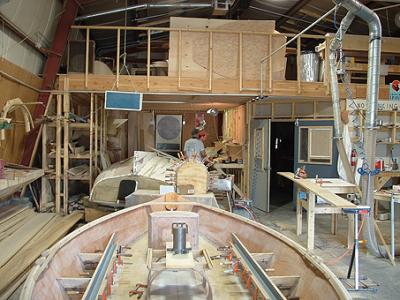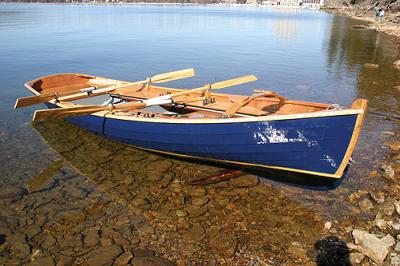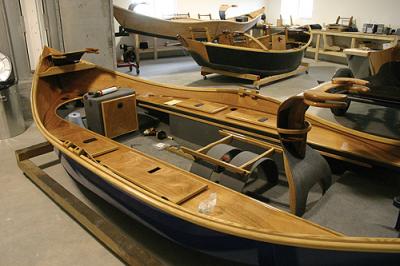The Dory Evolves in Paradise Valley
Custom Boat-Builders in Paradise Valley....

A short way up the Paradise Valley, along the Yellowstone River, and not far from the Pine Creek boat ramp, a modest home sits. Around this home stands a clustering of outbuildings. At first glance the place is nothing out of the ordinary; however, inside these simple post and beam shops, the next step in dory or drift boat evolution is taking place. A wooden sign swings slightly in the ever-present Paradise Valley wind, and proclaims 26 Pine Meadow Road as the home of Jason and Vedra Cajune, his children, and Montana Boatbuilders.
While most people associate boat building with coastal regions, such as Washington, Oregon, and the Eastern Seaboard, Jason Cajune’s opinion is that Southwest Montana is the drift boat center of the country. Count the number of boats from the 9th Street Bridge in Livingston to the Pine Creek access on any given day during the fishing season, and one can see that he is right. As boat builders go, Cajune and his full time crew of six are at the top of their game, and with each custom beauty that hits the water they become part of a history that is as interesting as Cajune’s own.
The McKenzie style riverboat is an adaptation on the design of the traditional wooden dory. History tells us that the dory appears to have originated circa 300 A.D. for surf and inshore fishing boats on the Arabian Sea. The design of the dory allows it to carry a lot of weight without drafting too much water. This in turn makes the dory ideal for handling rough, choppy water, and rapids. Unlike keel-boats, which slice through the water, a dory’s flat bottom adheres to the surface, thus allowing it to ride over waves, chop and rapids, as well as minimizing the on-take of water over the bow. These features make the dory a great boat for hand-lining, netting, whaling, and even lifeboat purposes.
Because of these qualities, this flat-bottomed design became popular throughout European seaports, and eventually the New World. Dories are still in use today from the warm seas of their origin to the icy waters of the Pacific off the coast of Alaska.

Somewhere on this Northwestern migration of time and water, the first McKenzie style drift boats were designed. Conceived on the banks of the Oregon river that shares its name, the McKenzie boat grew from the net-tending dories, and flat- bottomed logging skiffs of the early 20th century. As men who knew the rivers of the region began to guide clients, they also began to make alterations, and improve upon the designs of their boats. The old skiffs and dories were long, 18 to 22 feet, and extremely heavy, some over eight hundred pounds. Two of the most noted alterations of the traditional skiffs were a shortening in length (16’ or shorter), which made the boats lighter, and the addition of a slight rocker on the bottom. These innovations improved the boat’s overall maneuverability and gave the boat a slightly comical appearance of a pointed, floating bathtub with oar-locks.
Most sources credit the first truly functional river drift boat to a man named Veltie Pruitt. In 1925 Veltie a preacher/guide built a 13’ board and batten riverboat from 12” spruce planks and a cedar frame. This boat proved to be light, highly maneuverable, and could even be transported via car top. Over the years there were many improvements and alterations to Veltie’s design. In the 1930’s Tom Kaarhaus built his “Rapid Robert” out of the newly available water resistant plywood and waterproof glues. Kaarhaus is credited with the “Original McKenzie River Drift Boat.”
However, before the modern drift boat could be born, a few more changes had to be made. Circa 1940, Woodie Hindman began rowing his “Rapid Robert” backward, or bow first, through rapids. Hindman preferred the handling of the boat in this fashion and thus developed his “Prince Helfrich Double Ender.” The double ender had a higher and more pointed stern, which allowed it to cut more smoothly through rapids. This style boat was extremely popular in and around the McKenzie River area during the 1940’s. While several stories exist as to how the modern style McKenzie boat came into being, the majority of the credit usually goes as well to Woodie Hindman. With the flattening of the double ender’s stern into a small stout transom the boat became wider and could accommodate more gear, a small kicker outboard attached to the transom, and an anchor system could be added. Thus the modern McKenzie boat took shape.
This style boat eventually found its way to the great state of Montana circa 1950. Most sources agree that Pat Barnes can be attributed with the McKenzie boat’s introduction to the state via West Yellowstone for use on the Madison. Soon guides began to venture on to different rivers until McKenzie boats were common throughout Montana trout country. Guides and their boats continue to play an important role in the state’s economy.

As the McKenzie boat floats into the next century, Jason and Vedra Cajune and Montana Boatbuilders are there to row it along. Unlike most Montana kids of his generation, Jason didn’t spend his formative years cleaning horse stalls, baling hay, or driving grain trucks. Rather he spent his chore hours alongside various members of his family stripping, sanding, and refinishing the hulls of the Sinopah and other vessels of Glacier Park’s famous wooden boat fleet. Upon completing high school, Cajune attended Montana State University in Bozeman. After attempting various majors including architecture, engineering, as well as film and television, Cajun decided college wasn’t for him and took a job with a boat builder in Washington state with a vague plan to someday return to Montana. Jason did come home, and in 1996, he and his wife started Montana Boatbuilders with some basic goals: Build high-quality fishing and hunting boats in Montana. The boat’s “gotta’ work right and gotta’ look good doing it.”
Cajune admits of his fledgling company, “At first I figured I’d build boats in the winter and guide in the summer.” The only problem with that theory is, when your boats look and perform as well as Cajune’s, the word gets out.
Montana Boatbuilders can attribute their success to the uniqueness of their product. While the boats look beautifully fragile, with gracefully flowing lines, and high gloss finishes, they are actually very rugged. The ruggedness of these boats is carefully hidden within their complex, and surprisingly technologically advanced design. MBB boats are not all wood, nor are they all fiberglass; rather, they are a hot-rod hybrid of both modern and traditional boat building technologies.
Most people in the outdoor recreation industries have been led to believe by the fiberglass and aluminum boat companies that wood is high maintenance, easily damaged, and has a short life compared to their products. This attitude has prevailed. But MBB boats should soon explode that stigma.
Using a combination of high strength marine epoxies, in conjunction with high quality fiberglass, MBB has eliminated the need for a wooden frame. The hulls of MBB’s boats are made of finest quality wood, which rids them of the cheap look and feel of mass-produced all fiberglass boats, yet adds the warmth, stealth, and class of wood. Combine these elements with MBB’s proven layering process, and the end result is a boat bottom that is virtually bomb proof, and superior to any mass-produced boat on the water today.

The interior of the boats is coated with pick-up bed liner that is easy to clean, yet doesn’t become slippery when wet. Seating and storage options are really up to the customer, as is color. All of MBB’s boats are custom and as individual as each customer. Each boat is built totally from the ground up at the shop, and is constructed of the finest materials available.
While Montana Boatbuilders manages to produce about 20-24 custom boats a year, there is still a six month to a year waiting list on new orders. As with any custom project, MBB’s boats are not in the bargain basement category. The base price of the most inexpensive sits at just under $5,000. However, the bitterness of poor quality lasts long after the sweetness of a low price is forgotten. According to the Cajune’s, they’ve never had a disappointed customer.
Jason and his crew will also do repairs jobs on almost anything, except aluminum. Their repair work has given Jason and his crew, first hand experience with the construction of other boats, thereby adding strength to their conviction that Montana Boatbuilders builds the best drift boat in Montana, and quite possibly the world. Therefore, they deserve being written into the story of the drift boat, as well as fly-fishing history in Montana.
For more information on Montana Boatbuilders check out their web site at, www.montanaboatbuilders.com
~ Kurt A. Dehmer is a fourth generation Montana ranch kid, fishing/hunting guide, and writer. He is married to his dream woman, and they live with their chocolate lab, and white kitty in Bozeman, Montana. USA.
Leave a Comment Here
Leave a Comment Here